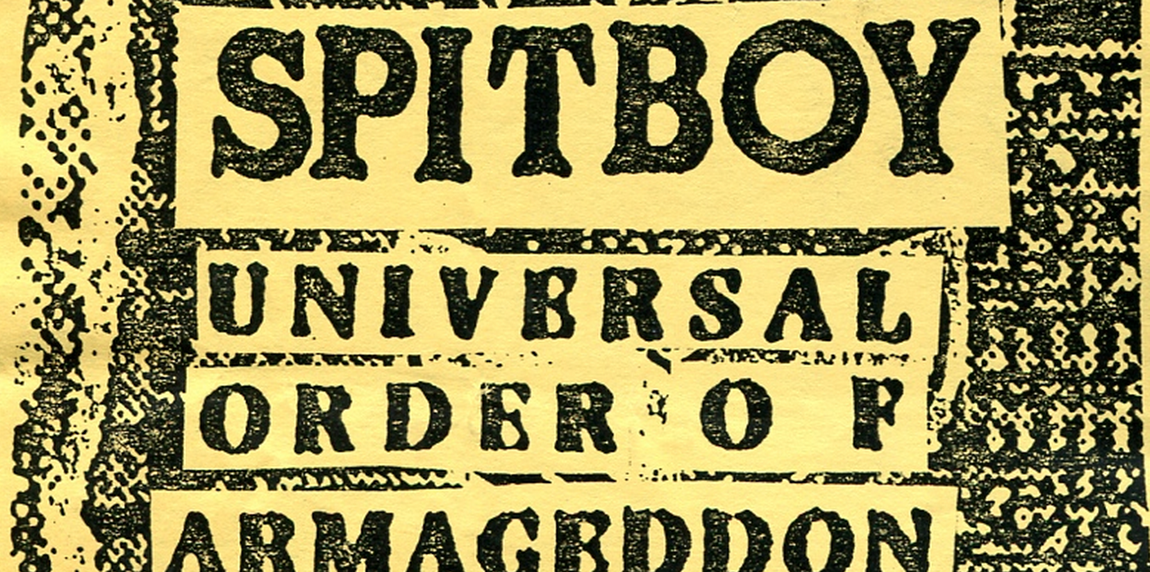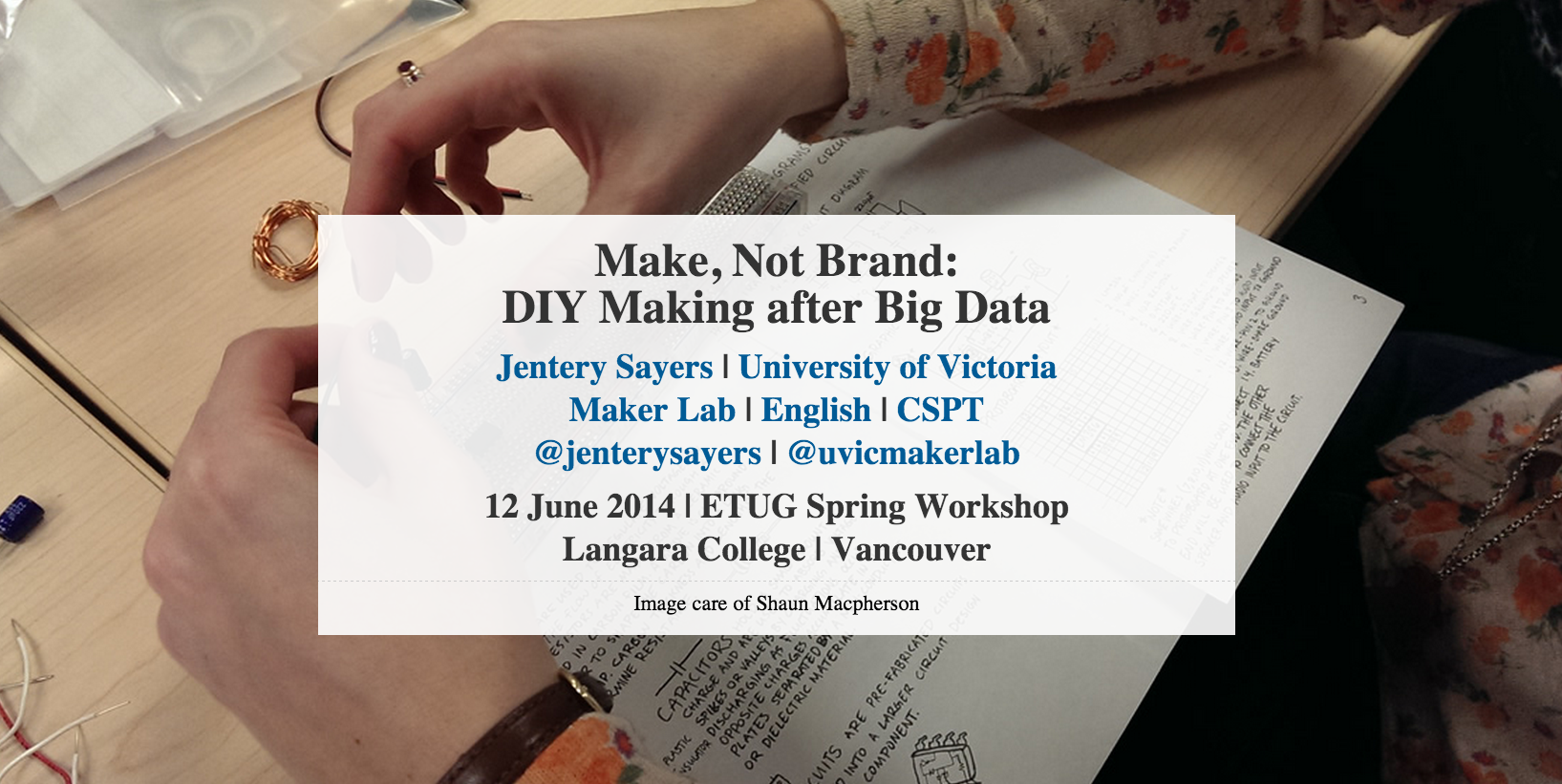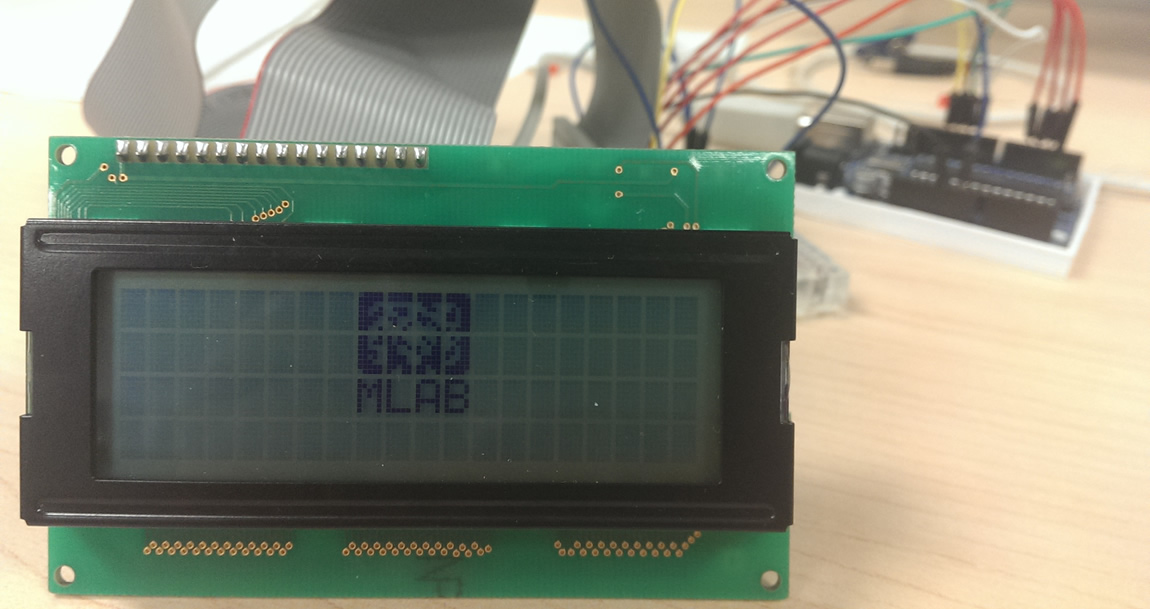On June 14th, I had the privilege of giving the keynote address at the Educational Technology User Group’s 2014 Spring Workshop. The title of my talk was “Make, Not Brand: DIY Making after Big Data.” I published the slidedeck for my presentation online, and you can also download or fork it via GitHub. It contains references to existing work that influenced and shaped my argument about maker cultures in a big data moment, including work by 924 Gilman St., Timo Arnall, Jonathan Beller, Nicolas Collins, Aaron Cometbus, Free Geek Vancouver, merritt kopas, Radhika Gajjala, Garnet Hertz, Evgeny Morozov, Bethany Nowviskie, Open3DP, Alison Powell, QZAP, Tara Rodgers, and Jathan Sadowski and Paul Manson. To navigate the slidedeck, just use your space bar or arrow keys.
Here’s a video recording of the talk (thank you, ETUG!), and below the video are my notes, which are much more condensed and easier to scan than the video. (Confession: I revised them just a touch for the purposes of this post.)
Making: A Response to Big Data: The resurgence of maker cultures (or attention to maker cultures) may be productively understood in relation to all the current buzz about big data, which is anchored in abstraction: the abstraction of reading into usage statistics, of literature into graphical expressions, of social relations into network visualizations, of everyday activity into quantified selves, of people’s bodies by computer vision. Put differently, big data compresses the voluminous and multiple into the communicable and comprehensible. Meanwhile, maker cultures tend to build situated and small. Instead of addressing grand challenges and big questions, they often underscore how the particulars of context influence technological development, interaction, and epistemologies. Additionally, they usually focus on some physical mess at hand, in contrast to big data’s frequent attention to screens. By extension, while big data is usually invested in processing power and data visualization, maker cultures invest in obsolescence, waste, demanufacturing, and reuse—in the discards and leftovers of people’s computing projects.
If we want to further understand such distinctions or differences between big data and maker cultures, then the following concepts might prove useful: scale (e.g., micro, macro, distant, and close), productivity (e.g., play, automation, and “not reading”), materiality (e.g., software, platforms, and bodies), modality (e.g., hands-on, vision, and scanning), and rhetoric (e.g., digging, revealing, and hacking). For example, what are the politics of scale? Of thinking big or small? How are data and making intertwined with assumptions about efficiency? About what’s being generated during a time of austerity? What is the stuff of computational methods, and to what extent is it visible to audiences? What modes of knowledge production are privileged or even fetishized when we use certain technologies? And how are these modes communicated to broader publics? Such gestures prompt us to unpack how the technologies we make, use, and hack are culturally embedded. And they are the kinds of questions we routinely ask in the Maker Lab. For now, though, I want to focus on the perceptions of both big data and maker cultures in post-secondary education. My primary question is why making now, in a big data moment.
Making Is a Hobby: If we locate big data and making in post-secondary education, then we will likely see another curious tension: big data is rendered scientific or rigorous while do-it-yourself making is relegated to an elective or hobby. Perhaps unsurprisingly, a recent market study by Maker Media and Intel (see graph above) suggests that “makers” are far more likely to identify as hobbyists or tinkerers than educators or academics. To be sure, there are numerous social and cultural factors that help explain this tendency, and we might want to put some pressure on who, exactly, Maker Media and Intel surveyed. But one possible explanation for making-as-hobby is how it’s branded—how maker cultures are communicated, represented, and sold to audiences during, say, a moment when big data research is growing in popularity.
Make Is a Brand: When people hear the word “make,” they often think of Make, the brand. More precisely, Maker Media has the following brands: MAKE magazine, Maker Faire, Maker Shed, and makezine.com. While these brands do significant work to build and foster maker cultures around the world, they are not free from criticism, including criticism from academics and educators. For instance, they generally frame making as an affluent leisure practice (see Hertz), or they appeal to hobbyists who actually have the time and materials to make stuff (e.g., on the weekends or after school). Additionally, they rarely address directly how different forms of making are gendered (see Powell). Here, consider the ways in which building robots and weaving wearables are culturally embedded and normed. What’s more, it is difficult to parse Make as a brand from the economic or possessive individualism it enables (see Sadowski and Manson). In many Make materials, there’s not a small degree of bootstrap narrative or Macgyver-style DIY. These materials are conducive to a sort of romantic withdrawal from material conditions, and they can be easily rendered instrumentalist (see Morozov). Finally, the Make brand is not inclined to deeply historicize making through a longer legacy of—for example—weaving, fibreculture, and embodied labor (see Gajjala). As such, educators and researchers might draw from the enthusiasm and curiosity that pervades Make while asking how to better integrate making into collaborative, collective, cultural, and self-reflexive work. In the context of post-secondary education, we might ask how to blend critical and immersive practices when making things, and to what effects on our relations to, for instance, big data.

Spitboy and UoA flyer care of this visual history
Make Is Not a Brand: In more recent histories of DIY (and to be sure, many not-so-recent ones, too), we can find examples of such a blend, perhaps peripheral (or even antagonistic) to the Make brand. These histories have deeply influenced the work we’re doing in the Maker Lab, and they are not really about branding or marketing creative activity. Instead, they are about collective organization through shared acts of composition, hacking, performance, and reflection. For instance, in handmade electronic music, there’s an investment in approaching technology as a personal or cultural history (see Rodgers) as well as something that can be hacked or repurposed (see Collins). Making electronic music by hand frequently advocates working backwards (or reverse engineering), documenting what works and what doesn’t, and bending electronics toward new expressions. In materials, you also find many self-aware (and often humorous) tutorials, which suggest that technical education need not be bland or decontextualized in its didacticism. It can self-reflexively represent the culture from which it emerges, avoiding both technological instrumentalism and determinism in the process.
Additionally, in DIY publishing and zine-making cultures, the “yourself” in DIY is largely collectivist in character (see QZAP, Cometbus, and the Riot Grrrl Collection at Fales Library). Many zines anchored in, say, punk or riot grrrl scenes spend significant time attending to the everyday of those scenes—to the cultural practices or otherwise overlooked people involved in making scenes happen. There’s a heightened sense of audience, and the writing is usually autobiographical or immersive in style, with an investment in self-awareness, affect, creativity, and humor. Like the Spitboy and UoA flyer above, these zines are typically arranged or designed by hand; composed through a combination of images, type, cursive, and manuscript; xeroxed; traded for other zines; and (when sold) kept cheap and affordable. You will also find them circulating in many not-for-profit music venues (see 924 Gilman St.), where space is recognized as something that’s value-laden and thus constructed (not given or abstract). Some of these venues are formalized (see the Vera Project), while others begin and congeal in people’s homes (e.g., Dick St. in Greensboro, NC), with flexible or pop-up architecture that affords the same space multiple functions.
Comparable to the DIY publishing of zines, not-for-profit venues and house shows emphasize experimentation and personal experience over expertise. The point is to get work in circulation and build a presence around a certain idea, belief, style, or emerging genre. There’s also a rather ambivalent relationship with technology, which—on the one hand—supports the expression and transmission of DIY aesthetics while—on the other hand—is not the end goal, fetish, or focus of such expression and transmission. The key, then, is framing a technology as something that’s central to making art and culture, rather than subordinating it tool-like to a means of mechanical or digital reproduction (see Rancière). More recently, we see similar impulses in DIY-inflected projects such as Forest Ambassador, Free Geek Vancouver, and Open3DP. Each of these projects appears deeply aware of how technologies are culturally embedded, and each also has a distinct impulse toward blending immersion with critical and creative endeavors. If there’s even a semblance of branding, then it’s subordinated to the project’s mission, its interests or ethos, and the needs or expectations of its audience(s).
The Relevance of Making in a Big Data Moment: Inspired by these recent histories and projects, and based on my own experiences with the Maker Lab, our “Hello World” workshops (supported by the DHSI), our Kits for Cultural History project, and teaching Digital Humanities courses at UVic, I have found that prompting people to make things in post-secondary education contexts—and especially in the humanities, which inform my perspectives here—has the following implications:
Learning about and through the platforms we frequently relegate to consumer technologies. If instructors and learners treat technologies as made or constructed things, then they are less likely to reduce them to delivery mechanisms or opaque objects. One byproduct of this emphasis is an attention to the roles that technologies play in scholarly practice and communication. Another is the opportunity to treat technologies historically, as part of post-secondary education’s cultural history. What technologies have been made for education, and why? By whom? Where did they go, and why were they adopted?
Blending tendencies toward abstraction with embodied knowledge. Encouraging people to learn by proxy, through manual trial and error, with hardware and electronics, or in situ for a particular project underscores why place and bodies matter in a big data moment, which is often represented by code, symbolic logic, data visualization, usage statistics, software, and screen-based interfaces. It can also get people thinking about how bodies or embodied activities are expressed as data (e.g., what’s lost in the translation? how is the data used? how does the multiple or heterogeneous function at scale?).
Combining learning through lectures with learning in collaborative workshops. It’s difficult to facilitate making in post-secondary education through lectures alone. Collaborative workshops (e.g., building a circuit, programming a microcontroller, or constructing a 3D model) also give people opportunities to openly bring their “hobbies” into learning spaces such as classrooms and talk about why their hobbies are relevant. During Digital Humanities 250 (“Things to Think With”) last semester, students and I often discussed the relationships between hobbyist and academic learning, and how learning gets categorized as such.
Routinely asking where and under what assumptions technologies function. Instead of speaking about “Technology” with a capital “T,” maker cultures tend to ask where stuff comes from, how it’s advertised, to whom, by whom, and where it goes. On our campuses, such impulses can spark some necessary conversations about labor, manufacturing, social justice, and planned obsolescence, especially during a moment when people spend a lot of time staring at graphs, screens, and whiz-bang applications.
Integrating immersion and experimentation into the humanities. With a focus on what changes over time, trial-and-error experimentation can do a lot for humanities research. In many of my courses at UVic, as well as in the Maker Lab, we keep research logs, which allow people to document and ultimately reflect upon what worked and what did not. This attention to iterative development can also help people translate—for others—how they made and unmade things, how certain platforms or mechanisms function, and how this idea became that one. It’s also useful for reverse engineering popular media and technologies (including graphical expressions) in order to better understand how they make arguments.
To be sure, we have much to learn from big data research, which is still relatively new to the humanities. But balancing it with other approaches to technologies—including the practices of many DIY maker cultures—can render it even more persuasive and robust. Doing so can also highlight how the abstract and the situated, the macro and micro, the big and small operate recursively (rather than dichotomously or in opposition). Of course, as with any act of making something, there’s no escaping alienation or abstraction. But escape need not be the point. The point of making things in post-secondary education is (among others) to become more aware of how both processes and products are culturally embedded, how they change over time, and how—in a big data moment—they become abstracted from everyday life in the first place. Beyond Make the brand, we have many DIY histories, cultures, and collectives that can inform our next steps.
Post by Jentery Sayers, attached to the Makerspace category, with the news, physcomp, and fabrication tags. Primary image for this post care of Jentery Sayers and Shaun Macpherson.



